Anna Knox – 4 August, 2020
Entering the show you first notice a long, spit-like installation creeping along the right-hand edge of the room. It's an escalating coral-like shambles reminiscent of the rocky contours of Wellington's South Coast, made up of hundreds of brightly coloured small shapes and replicas of objects formed with clay and paint (like clothespegs, lions, spaghetti, birds-nests, some miniature ‘Mt Taranakis').
Wellington
Rebekah Rasmussen
Loose Parts and Joyful Mayhem
27 July - 15 August 2020
In Rebekah Rasmussen and Te Aro Kura’s Loose Parts and Joyful Mayhem, currently showing at Wellington’s Toi Pōneke, the emphasis might well have been the ‘mayhem’. The artist has confessed that until she got into the gallery she had no idea what the exhibition was going to be. She arrived to install with two car-boot loads full of fragile, often half-collapsing constructions produced in workshops with children from Te Aro school last year, along with some of her own equally fragile works inspired by those workshops, using the same classroom construction materials.
Wobbling towers of cardboard tubes and skewered sponges, flimsy toothpick ladders, boxes of painted blocks and clay balls, brightly painted, all emerged, along with other more substantial constructions of paper maché and recycled objects. What she and a classroom produced with those boot-loads, following the reciprocal principle of ako (where teaching and learning blend) is a finished, playful and concise body of work. One that honours the children’s contributions thoroughly, and treads carefully around questions of ownership.
Two structural aspects conspire to pull together the artist’s most definitive work yet. One is a narrative about the creative process, which throws up all kinds of questions about what art is, how we value it, and what distinguishes ‘fine art’ from works produced in the classroom. (Not all of those questions are answered.) The other is the creation of something like a landscape. Walking through the show feels akin to experiencing a 3D flyover through a real model of a coastal city and its surrounds—a place like Wellington, perhaps.
Entering the show you first notice a long, spit-like installation creeping along the right-hand edge of the room. It’s an escalating coral-like shambles reminiscent of the rocky contours of Wellington’s South Coast, made up of hundreds of brightly coloured small shapes and replicas of objects formed with clay and paint (like clothespegs, lions, spaghetti, birds-nests, some miniature ‘Mt Taranakis’).
You could spend a long time examining this part in detail, trying to pick the children’s works from Rasmussen’s, but you have to come back, because there is a clear, narrative quality which pushes you along to the next thing: a single, relatively larger sculpture in proximity to the ‘coastline’, like an island. This is the artist’s response to the children’s paper maché sculptures, which are then clearly in front of you, raised on bright pastel-painted plinths, and looking like a coalition of guardians of the scrap, the dream, childhood, the mess of creating.
You walk towards them, then perhaps around, and then you turn to see in the second part of the Toi Poneke space another single, island-like sculpture, one taller than an adult reaching skyward, a prequel to what you then see when you look to the far end of the space, where the denouement of this escalating narrative is a fantastic, imposing, dream-like city.
And there you stop. Elegant, chaotic, rhythmic, vibrant, and always poised on inevitable collapse, the fragile, towering mass of blocks, tubes, wire, sponge, toothpicks, egg cartons, washi tape, clay, powdered pigment and paint, which conspire to raise this city into something at once tangible and imaginary, is a phenomenon that will momentarily still your breath. Then you’ll go forward to examine it more closely, looking for how it’s held together—and for the multitude of small works and stories and pieces of humour and darkness held within it.
The exhibition has an internal sense of a balance (a mirroring) which is deeply satisfying. Ladders made of thin, pale wire and toothpicks or matchsticks, feature prominently. The delicate, tower-like structures stand tall, and have a vivid sense of reaching for something, like children stretching for a top shelf. They are fragile, brave, always poised on inevitable collapse, and clearly embody the desire and ambition-the reach-we all feel when trying to create something worthy but perhaps beyond our capability. In contrast the ‘coastline’ objects hug the ground with their humble, grubby shapes, foraging, somewhat blindly, for what they might use. The first ‘island’, the artist’s response to the children’s plinthed sculptures, is firmly planted on the earth in a sea of bright-pastel powdered pigment-a dissolved plinth. My favourite work, it is serene, far away from all that reaching, and embodies the ambition and desire of the towering sculptures, and the grubbiness of the miniature clay pieces, resolved into something more mature and complete.
The artist has said that this project, and the process of it, has been about ‘the tension between looseness and rigidity; the looseness of the children’s approach to making, and the rigidity of an adult’s.’ But it is also about the containment of the adult. Children are always spilling-things, themselves, the workings of their minds and emotions-and their art reflects this. It is very much in process. Adults are usually more contained, working to balance their interior turmoil with outward composure. You see this very clearly in the ‘city’ part of the installation, which is tightly bound, its playful confusion and anxiety carefully delineated, and yet still visible, as are the two, neatly outlined and isolated ‘islands’. Earlier Rasmussen exhibitions sometimes had the conceptual art sceptic in me thinking yes, but… couldn’t my kid do that? This show puts a lid on such doubts; there is no way my kid could do this.
My kid did do a little bit of it though. On opening night my four-year-old approached the artist holding a little structure she had built using the blocks and play-dough provided for play on a low table in the reception room. ‘I’d like to put this somewhere,’ she said. I dived in anxiously. ‘Oh, how about over there on the food table?’ I suggested. ‘Or on the windowsill, by that plant?’ ‘That’s not what I meant,’ my daughter said with a frown. Rebekah looked at her. ‘You can put it in the big room if you like,’ she said, ‘in the artwork’. She beamed and walked off carefully carrying her creation into the exhibition space where she placed it, without too much thought, in the centre of the city.
Anna Knox
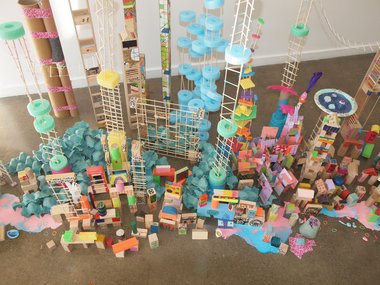
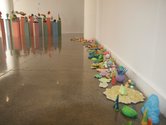

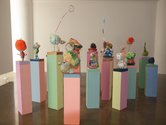
 Advertising in this column
Advertising in this column Two Rooms presents a program of residencies and projects
Two Rooms presents a program of residencies and projects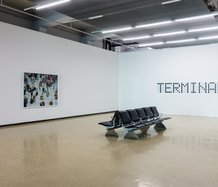
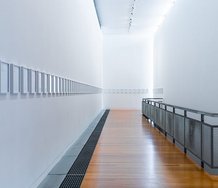
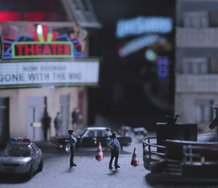
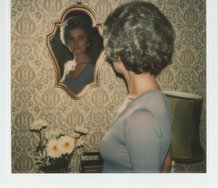
This Discussion has 0 comments.
Comment
Participate
Register to Participate.
Sign in
Sign in to an existing account.